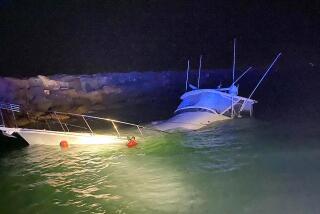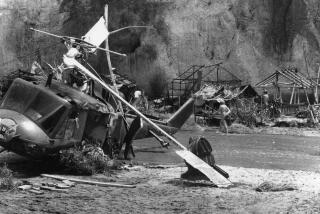Jury Deadlocks, 9-3, to Acquit in Boater’s Manslaughter Trial
- Share via
A mistrial was declared Thursday when jurors could not agree whether Virl Earles was guilty of involuntary manslaughter in a 1984 boating collision near Seal Beach that killed five people.
The jury deadlocked 9 to 3 for not guilty. Deputy Dist. Atty. John Conley said he did not know yet whether he would seek another trial.
Earles, 30, of Seal Beach was driving the boat when it struck an 11-foot-wide concrete buoy head-on late at night, killing five of his eight passengers. Earles and three other survivors were seriously injured.
The group had been returning to Anaheim Bay from a boat ride to view the Queen Mary on Oct. 28, 1984, when the collision occurred. The buoy was along the west side of the bay, well out of the channel boaters are required to stay in.
The prosecution, which sought five counts of involuntary manslaughter, contended that Earles was driving at an unsafe speed and failed to use caution in the nighttime conditions.
“I’m disappointed; we spent a lot of time working on this, and I thought we had a good case,” Conley said.
But Earles’ attorney, Gary Pohlson, said his client also was disappointed.
“He was glad that nine people believed he was not guilty, but he was really disappointed that it wasn’t all of them; he certainly wasn’t jubilant.”
Pohlson might have had grounds for a mistrial even if the jury had found Earles guilty. Jurors told him later that one of the three who had voted to find him guilty had learned that findings on Earles’ blood alcohol content after the accident had been suppressed by the court.
Conley’s strongest evidence during the preliminary hearing was that Earles’ blood alcohol content was slightly above the .10 measure the law defines as drunk. But the Municipal Court threw out the blood alcohol tests because police had failed to get his consent or to arrest him first.
He was able to show, though, that Earles and the others had been drinking before the crash.
After Superior Court Judge Jean Rheinheimer declared the mistrial, Conley said the suppression of the blood alcohol evidence might have cost him a guilty verdict, but he could not be sure.
The prosecutor said he might wait until next month to decide on a retrial.
“Certainly the way the jury was split (is) a big factor” against prosecuting again, Conley said.
Conley said he also will talk to the judge about her perceptions of the trial and will have his office talk to the jurors.
Conley said his office might come up with additional witnesses, but he did not elaborate.
“Certainly if we put on the same case we just had, the outcome is not likely to be any different,” Conley said. “We’re going to need something else.”
Pohlson said his client will go back to his job at a construction company.
Pohlson also said he was not pleased with the outcome.
“It was an emotional trial for me in that I felt strongly he was not guilty; I feel disappointed too,” Pohlson said. “We came so close to getting an acquittal.”
Earles testified that he was going at least 25 miles an hour in a 5-mile-an-hour zone when he crashed. But he contended that a temporary harbor light confused him about the course he was on; he said he thought he was safely in the middle of the channel leading back to the inner harbor.
Those killed were John Bakos, 22; Ronald Myers, 22; Anthony Sutton, 27, all of Seal Beach; Kathy Weaver, 24, of Laguna Beach and Patricia Hulings, 20, of Downey.
Earles was thrown from the boat and severely injured. Carol Kemble, 25, of Laguna Beach and Earnest Chavez, 25, of Bakersfield were thrown into the water but managed to climb onto the buoy. They held Earles’ head out of the water as he lapsed in and out of consciousness.
Stephen Brennan, 24, of Huntington Beach, the fourth survivor, managed to swim ashore for help despite a shattered pelvis and internal bleeding.
More to Read
Sign up for Essential California
The most important California stories and recommendations in your inbox every morning.
You may occasionally receive promotional content from the Los Angeles Times.













